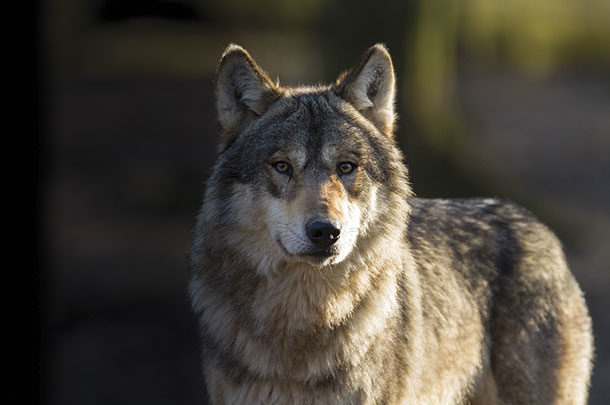Public opinion in a number of Western states, such as Oregon and California, favors nonlethal control of wolves over the lethal alternatives. However, continued livestock depredations by wolves will only intensify the negative attitude towards wolves by members of the agricultural community.
Not only do wolves kill livestock, but the stress that is instilled in livestock by wolves leads to economically significant losses in weight gain and reproduction rates. Therefore, it is important that nonlethal options are explored and the data regarding their effectiveness is considered so that these tools can be properly utilized to create the best possible result.
Fladry
Fladry is a nonlethal management tool that uses flags that hang down from a rope hung along a fenceline. Fladry has historically been used for hunting wolves in Europe and Russia. The theory behind fladry is that it would create some kind of “visual barrier” wolves feel apprehensive about crossing, thus creating a neophobic response.

The overall body of scientific literature seems to demonstrate that fladry can be effective at keeping wolves from crossing fencelines for a finite period of time but may not be useful in the long run. Scientists have observed that fladry may keep wolves from crossing fencelines for approximately 75 days. Certain factors such as the human scent that is left from the act of installing and maintaining the fladry may have contributed to the effectiveness of the fladry in these trials.
Other factors that may affect the length of time fladry is effective is how often the wolves encounter fladry and the individual animal’s determination. In addition, things such as falling branches, wildlife and cattle crossing, as well as heavy snowfall can cause fladry to fail.
Since it has been estimated that using this tool costs around $1,400 and 20 work-hours per mile, as well as the additional time and labor required to maintain the fladry, the cost of this management tool will often outweigh its benefits.
Flash and sound devices
There are a number of commercially available devices that create patterns of light and/or noises meant to provoke the flight response in predators, and they have been demonstrated to be effective to a certain extent. Examples of these include strobe lights, sirens, propane cannons and even inflatable air dancers you may see in a used car sales lot. These devices can either be set to carry out their functions on a set schedule, or they can be motion-activated.
Relevant scientific research has demonstrated that these motion-activated flash and sound devices are more effective in deterring predator activity than fladry or having no management tool in place at all. However, it seems the effectiveness of motion-activated flash and sound devices is also temporary. It has been observed that many species of wildlife eventually become habituated to these devices, thus diminishing the flight response in wolves and other predators.
In addition to habituation, the availability of alternative, unprotected food sources is another factor that may affect the effectiveness of flash and sound devices. If there are other sources of food for predators that are not protected in any way, it is likely the predators will choose the unprotected food sources rather than a food source where they may encounter some type of frightening stimuli.
Using these devices happens to be both economically and management friendly. These devices can easily be picked up and moved without a whole lot of time and effort. Also, many flash and sound devices can be bought for $100 or less.
Management
Various management and husbandry practices can be used to minimize instances of livestock depredation by predators. One obvious management strategy is carcass removal. Dead carcasses serve as a potent attractant for predators. Quickly finding and moving carcasses away from livestock is one of the more effective strategies for minimizing livestock depredations. Hiring range riders has started to become a more common practice that not only helps livestock managers quickly find and move dead carcasses but also increases human presence in pastures, which will subsequently decrease predator activity in those pastures.

It is worth noting that hiring range riders has not proven to be cost-effective in many cases. However, donations of time, equipment, horses, housing, as well as the possibility of receiving grant funding from government agencies can help make range riding a more viable option for livestock managers.
Changing the season where calving takes place is another viable option for decreasing incidents of depredation. Wolves generally breed as winter is coming to an end, and after a 63-day gestation period, they give birth to pups from mid- to late spring.
With the wolves either being pregnant or having to provide food for their pups in the spring, this means their nutrient requirements are at their highest during this time, subsequently leading to more depredations. Since calving season is when livestock are at their most vulnerable to depredation, switching calving season from spring to fall may significantly reduce depredation occurrences.
Guard animals
The use of guard animals to protect livestock is a management strategy that has been used for thousands of years that will either decrease or eliminate livestock depredations. Guard animals are commonly associated with sheep and goats, but they have also been successfully used to protect herds of beef cattle.
Dogs have proven to be the most effective in protecting livestock from predators. However, using dogs as guard animals comes with some disadvantages. Using a guard dog requires a commitment by the owner to provide proper nourishment since dogs can’t feed on the pasture being used by the livestock they are protecting.
Guard dogs can also be overly aggressive to humans or even the livestock they are supposed to protect. This can lead to some major issues when the dog wanders onto neighboring properties, given their natural disrespect for property boundaries. A lot of these issues can be prevented by raising the dog with livestock starting at 6 to 8 weeks of age, since pups older than 8 to 10 weeks of age may have passed their primary stage of socialization.
Llamas and donkeys are also commonly used as guard animals, but have demonstrated to be less effective than guard dogs. Llamas and donkeys do have a natural repugnance toward predators and will aggressively chase down predators such as foxes, stray dogs and coyotes. However, they may run away from bigger predators such as mountain lions, wolves and bears.
Advantages of using a guard llama or donkey includes long life expectancy (10 to 20 years) as well as being a very low-cost and low- maintenance option due to the fact llamas and donkeys will utilize pasture forages for nourishment, just like the livestock they are guarding. A guard llama or donkey should be placed with livestock at around 3 to 6 months of age to make sure they are bonded with the herd and will be motivated to serve their purpose as a livestock guardian.
Conclusion
Whether you live in a state that outlaws lethal control or not, it is important to consider the previously described nonlethal techniques to make informed decisions to decrease predator activity on ranches and help to improve the public perception of ranching. Although all of these nonlethal techniques have their own limitations in effectiveness, perhaps a strategic combination of some of these tools according to each individual production scenario can serve to be extremely effective for some livestock producers. ![]()
PHOTO 1: Taking out wolves lethally may seem to be the natural remedy. But in regions where it’s frowned upon, studies show how effective nonlethal methods actually are. Getty Images.
PHOTO 2: Fladry that has been set up on a ranch in Klamath County is pictured. Photo provided by Ian McGregor.
PHOTO 3: Moving dead carcasses away from livestock is an effective way to keep wolves away from your herd. Photo courtesy of Oregon Department of Fish and Wildlife – Tom Collom.
References omitted but are available upon request. Click here to email an editor.

-
Ian McGregor
- Oregon State University
- Assistant Professor (Practice) of Livestock & Irrigation
- Email Ian McGregor












